Tlaltecuhtli › Tarascan Civilization » Ancient origins
Articles and Definitions › Contents
- Tlaltecuhtli › Who Was
- Tarascan Civilization › Antique Origins
Ancient civilizations › Historical and archaeological sites
Tlaltecuhtli › Who Was
Definition and Origins
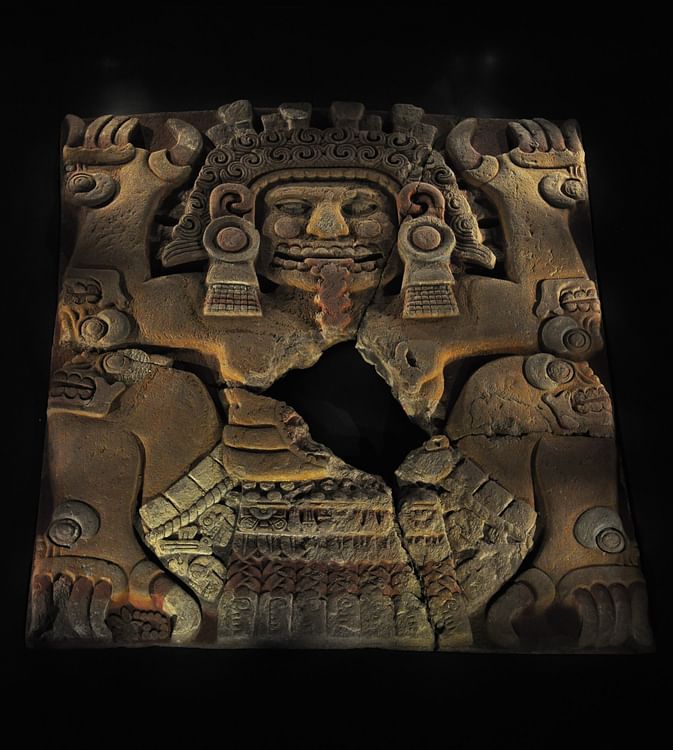
Tlaltecuhtli, 'Earth Lord/Lady,' was a Mesoamerican earth goddess associated with fertility. Envisioned as a terrible toad monster, her dismembered body gave rise to the world in the Aztec creation myth of the 5th and final cosmos. As a source of life, it was thought necessary to constantly appease her with blood sacrifices, especially human hearts.
NAME & ATTRIBUTES
Envisioned as a goddess but perhaps possessing dual gender like one or two other Mesoamerican primordial deities, Tlaltecuhtli, with its male suffix, may be literally translated as 'Earth Lord' or, more typically 'Earth Lady.' The goddess was imagined as a fat toad-like monster with a big mouth, fangs, and clawed feet. Considered the source of all living things she had to be kept benevolent by blood sacrifices which would ensure the continued order of the world.
THE CREATION MYTH
The idea of a creation myth involving a savage aquatic monster with crocodile features goes back to the Classic Maya and the 5th century BCE, a figure which was perhaps based on a similar shark-like monster in even earlier Olmec mythology. In the creation mythology of the Aztecs and other Mesoamerican cultures of the Late Postclassic period (13th-16th century CE), the gods Quetzalcoatl and Tezcatlipoca, taking the form of gigantic snakes, descended from the heavens one day and found Tlaltecuhtli sitting astride the ocean. In some versions, this creature is known as Cipactl or 'spiny one.' The hideous monster, with large fangs, crocodile skin, and gnashing mouths at her elbows and knees, called menacingly for flesh to feast on. The two gods realised that the 5th and final cosmos could not possibly prosper with such a fiendish creature roaming the world and so they took it upon themselves to destroy her. A mighty tussle ensued in which Tezcatlipoca lost his left foot. Finally, one god took the right hand and left foot while the other took the left hand and the right foot, and with a mighty heave, they managed to rip Tlaltecuhtli in two. From the upper half came the sky and the other lower half became the earth.
THE GODS DECREED THAT THE VARIOUS PARTS OF TLALTECUHTLI'S DISMEMBERED BODY SHOULD GIVE RISE TO FEATURES OF THE NEW WORLD.
The other gods were not best pleased to hear of Tlatecuhtli's treatment and so decreed that the various parts of her dismembered body should give rise to features of the new world. Thus, her skin became grasses and small flowers; her hair became the trees, flowers, and herbs; her eyes became springs and wells; her nose became the smaller mountains and valleys; her shoulders the larger mountains; and her mouth became the caves and rivers.
Despite being ripped to pieces and transformed into geographical features, the Mesoamericans still continued to think of Tlaltecuhtli as an earth goddess, and they attributed any strange sounds coming from such features as either the screams of Tlaltecuhtli in her dismembered agony or her calls for human blood to feed her. Indeed, the goddess gained a reputation for having an insatiable appetite for the hearts of sacrificial victims. This appetite had to be satisfied or the goddess would cease her nourishment of the earth and crops would fail.
Another aspect of the goddess was that Tlaltecuhtli was thought to swallow the sun every evening and regurgitate it the next morning at dawn. This solar connection ensured she was part of the prayers offered to Tezcatlipoca before an Aztec military campaign. Finally, midwives called on her aid during difficult births, and she appears in the Aztec calendar as the 2nd of the 13 Lords of the Day, with her date glyph being 1 Rabbit.
REPRESENTATION IN ART
Tlaltecuhtli, in various forms, is an ancient Mesoamerican deity but the earliest representations in sculpture are found at the Maya city of Mayapan in Yucatan. These date to the Late Postclassic period. More common in Aztec art, the goddess is often represented as a spread-eagled figure representing the hocker or squat adopted when giving birth. Her mouth usually gapes with fangs or teeth of flint blades, and she may have the skin of a crocodile which represents the surface of the earth.
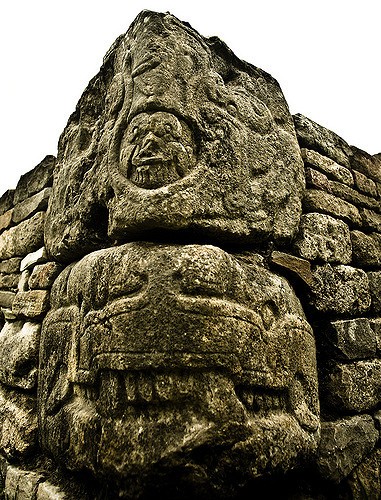
Tlaltecuhtli, El Tajin
The most famous representation of Tlaltecuhtli is on the colossal stone slab found near the base of the Templo Mayor of the Aztec capital Tenochtitlan (now central Mexico City). The pink andesite stone was broken into four pieces by the weight of a colonial building once above it. Put back together, it measures 4 x 3.5 metres and weighs around 12 tons. Carved in high relief on the stone is the familiar squatting figure of Tlaltecuhtli wearing a skull and bones dress and with a river of blood flowing into her gaping mouth. The stone may have been used to mark a royal burial, perhaps that of Ahuitzotl, as indicated by a year glyph (10 Rabbit or 1502 CE) and the nature of the goods buried under it, which are still being studied by archaeologists.
Another representation of the goddess is found on all four sides of the 1503 CE Coronation Stone of the Aztec ruler Montezuma II (aka Motecuhzoma II ), and with her, the glyphs for water and fire, traditional symbols of war. The historian ME Miller is of the opinion that the face in the centre of the celebrated Aztec Sun Stone (aka Calendar Stone ) is, in fact, Tlaltecuhtli and she there symbolises the demise of the 5th and final sun of the Aztec cosmos.
The goddess was often carved onto the bottom of sculptures where the base touched the earth and on the undersides of the special stone boxes known as cuauhxicalli ('eagle box') which were used to keep the sacrificed hearts she was so partial to.Finally, Tlaltecuhtli appears as a fanged toad monster in the form of a cornerstone of a pyramid platform at El Tajin. This links the architectural function of the stone as supporting the pyramid to her mythological function of supporting the earth.
Tarascan Civilization › Antique Origins
Definition and Origins
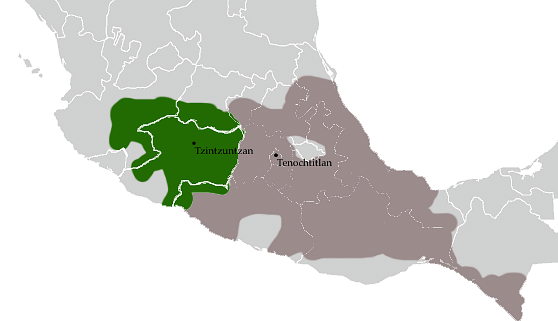
The Tarascan civilization (also known as the Purépecha, after their language) dominated western Mexico and built an empire that would bring it into direct conflict with that other great Mesoamerican civilization of the Post-classic period, the Aztecs. Second only to the Aztec empire, the Tarascans themselves controlled, from their capital of Tzintzúntzan, an empire of over 75,000 square kilometres.
CULTURAL ORIGINS
The history of the Tarascans has been pieced together from the archaeological record and local traditions, principally those related in the Relación de Michoacán written by the Franciscan friar Jeronimo de Alcala in the mid-16th century CE. Whilst the Tarascans owed a cultural debt to the earlier Bajio and Michoacán tribal civilizations, the Purépecha culture in fact had a history of over two millennia. The Tarascans were based in the central and northern Michoacán (meaning 'place of the fish masters') around the lake basins of Zacapu, Cuitzeo and Pátzcuaro. From as early as the Late Pre-classic period (150 BCE - 350 CE), Purépecha society developed into a more sophisticated culture with a high degree of political centralisation and social stratification by the Middle Post-classic period (1000/1100-1350 CE). According to the Relación the most important tribe were the Wakúsecha (from the Chichimec ethnic group), whose chief Taríakuri established the first capital at Pátzcuaro around 1325 CE.
The territory controlled by the Tarascans was now double the extent of previous generations and the production and trade of maize, obsidian, basalt and pottery correspondingly increased. The rising level of the lake in the Pátzcuaro basin also meant many low-lying sites were abandoned and the competition for resources became ever more fierce. So too, in the higher lands of the Zacapu, population concentration greatly increased so that 20,000 people inhabited just 13 sites. This period was marked by an increase in local state rivalries and a general instability amongst the ruling elite but the foundations of the great Tarascan empire were now in place.
THE TARASCANS MANAGED TO REMAIN UNCONQUERED BY THE MIGHTY AZTEC EMPIRE.
TZINTZÚNTZAN
From the late Post-classic period (1350-1520 CE, also known as the Tariacuri phase in this context) the Tarascan capital and largest settlement was at Tzintzúntzan on the northeast arm of Lake Pátzcuaro. The Tarascans also controlled, through a highly centralised and hierarchical political system, some 90 plus cities around the Lake. By 1522 CE the population of the basin was as high as 80,000, whilst Tzintzúntzan boasted a population of 35,000. The capital was the administrative, commercial, and religious centre of the Tarascan empire and seat of the king or Kasonsí. Extensive irrigation and terracing projects were carried out in order to make such a large population sustainable on local agriculture but significant imports of goods and material remained a necessity.
A network of local markets and a system of tributes ensured there was a sufficient quantity of basic goods but there was also a ready supply of pottery, shells and metals (particularly gold and silver ingots), and also labour, to meet demand. At these busy marketplaces fruit, vegetables, flowers, tobacco, prepared food, craft goods, and raw materials such as obsidian, copper, and bronze alloys were bought and sold. The state controlled the mining and smelting of silver and gold (in the Balsas Basin and Jalisco), and the production of goods made from these precious materials came via skilled craftsmen who probably resided in the palace complex of Tzintzúntzan. There is some evidence of independent gold and silver production in the south-east and western regions, compatible with evidence of secondary and tertiary administrative centres. In addition, the Tarascans imported turquoise, rock crystal, and green stones whilst from local tribute they acquired cotton, cacao, salt and exotic feathers. The Tarascans were themselves the most important producers of tin-bronze, copper and copper-alloy bells (used in ceremonial dances) in Mesoamerica.
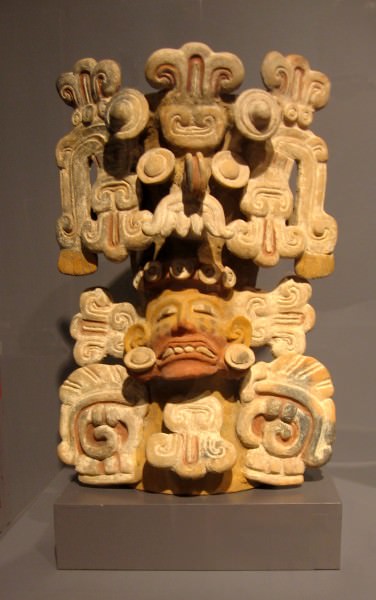
Tarascan Incense Burner
The Tarascan state also controlled land allocation, copper and obsidian mines, forests, the fishing industry and craft workshops in general. However, the degree of control is unclear and local communities and traditional tribal leaders may well have granted royal access to these resources. These diverse ethnic groups within the empire, although subject politically to Tzintzúntzan, also maintained their own language and local identities but in times of war their regular tribute to their Tarascan overlords was augmented by the supply of warriors.
According to the Relación de Michoacán the Tarascan nobility was divided into three groups: royalty, upper and lower nobility (the Wakúsecha elite). Royalty resided at the capital and the sacred site of Ihuátzio, which in fact had been the previous Tarascan capital. The funeral of one Tarascan king is described in the Relación where the dead ruler's entourage are sacrificed to accompany him in the land of the dead - 40 male slaves, his seven favourite female slaves, his cook, wine-bearer, toilet attendant and lastly, the doctor who had failed to prevent his death.
RELIGION
The Tarascan religion was led by a Supreme High Priest who was the head of a multi-layered priestly class. Priests were easily identified by the tobacco gourd they wore around their necks. Tarascan religion claimed the Pátzcuaro basin as the centre of the cosmos, or at least its power centre. The universe had three parts: the sky, the earth, and the underworld. The sky was ruled by the most important deity, the sun god Kurikaweri, whose wife was Kwerawáperi, the earth-mother goddess.Their most important child was Xarátenga, the moon and sea goddess.
The Tarascans also seem to have taken earlier local divinities and metamorphosed or combined these with wholly original Tarascan gods. In addition, the gods of conquered tribes were usually incorporated into the official Tarascan pantheon.Kurikaweri was worshipped by burning wood and offering human sacrifice and blood-letting, and pyramids were built in honour of the Tarascan gods, five at Tzintzúntzan and five at Ihuátzio. A peculiar feature of the Tarascan religion was the absence of such common Mesoamerican gods as a rain god ( Tlaloc ) and a feathered serpent god ( Quetzalcoatl ). Neither did the Tarascans use the 260-day calendar but they did employ the 18-month solar year with 20-day months.
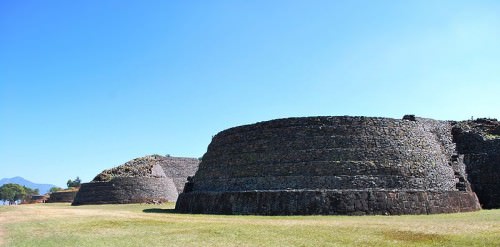
Tarascan Yacata, Tzintzuntzan
ART & ARCHITECTURE
A unique feature of Tarascan late Post-classical architecture is the monumental structures which combine rectangular and circular stepped pyramids known as yácata. These are shaped like keyholes but there were also regular rectangular pyramids. At Tzintzúntzan five such structures rest on an enormous platform 440 m long. The yácata were originally faced with close-fitting slabs of volcanic stone and excavations inside them have revealed tombs rich in artefacts. In front of the yácatasculptures were placed for receiving sacrificial offerings ( chacmools ) as in many other Mesoamerican cultures. At Ihuátzio there is also an example of a court for the Mesoamerican ballgame.
Tarascan pottery was also distinctive with its spouted jars with spur-shaped handles (sometimes taking the form of animals and plants), tripod bowls, miniature vessels and pipes with long stems, all highly decorated. The Tarascans were also highly skilled metalworkers, especially in silver and gold. In addition, they were expert workers of obsidian, notably earspool and labret jewellery, which was covered in gold sheet and inlaid with turquoise.
THE AZTEC THREAT
The contemporary expanding empires of the Tarascans and their southern/western neighbours the Aztecs eventually came into direct competition for territory and resources. Indeed, in a sense these two great Mesoamerican powers counter-balanced each other. The Tarascans, perhaps employing subterfuge and sabotage, did force the Aztecs to within 50 miles of Tenochtitlan in the 1470s CE which led to an agreement on a north-south frontier between the Lerma and Balsas rivers protected by fortifications placed strategically to command the vulnerable valleys. With this border secured the Tarascans continued their policy of expansion elsewhere. The best archaeological source of Tarascan military power and innovation is the fortress of Acambaro. Fortresses such as this one, the military strategies they employed and the use of metal weapons help to explain how the Tarascans managed to remain unconquered by the mighty Aztec empire.
Despite the hostilities between the two civilizations there is some evidence of trading between them, especially at strategic points such as the frontier trade city of Taximoroa but also through local tribes acting as middle men in the border 'buffer' zones. The archaeological record of cultural exchange in terms of artistic styles is, however, limited to a handful of pottery vessels found in the respective trading partner's territory.
When the Spaniards arrived in Michoacán in 1522 CE the Tarascans, who had previously ignored a plea of help from the Aztecs, came to relatively peaceable terms with the new masters of Mesoamerica and became a mere vassal state.
LICENSE:
Article based on information obtained from these sources:with permission from the Website Ancient History Encyclopedia
Content is available under License Creative Commons: Attribution-NonCommercial-ShareAlike 3.0 Unported. CC-BY-NC-SA License